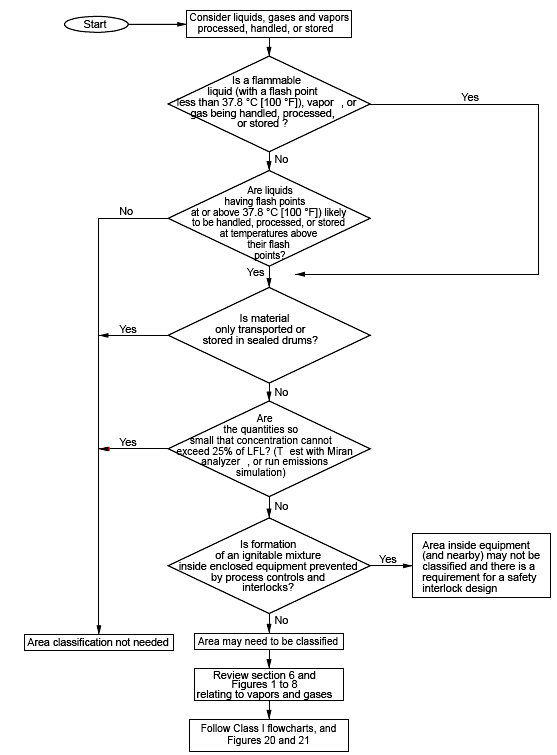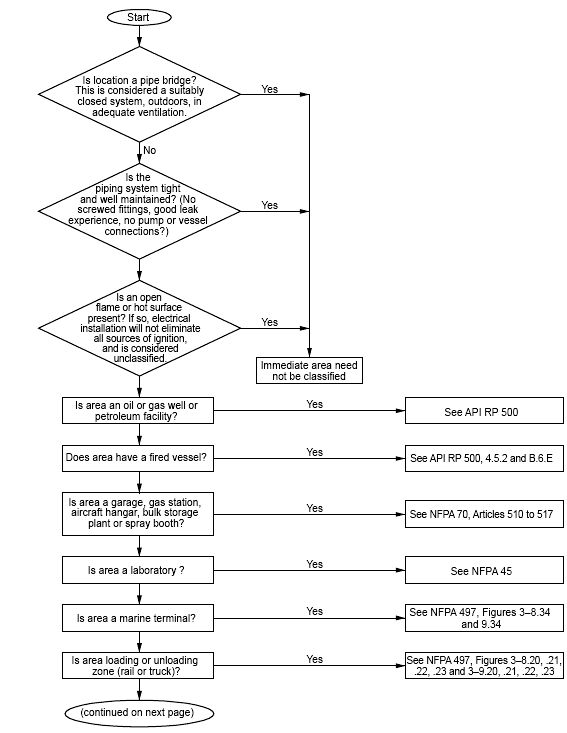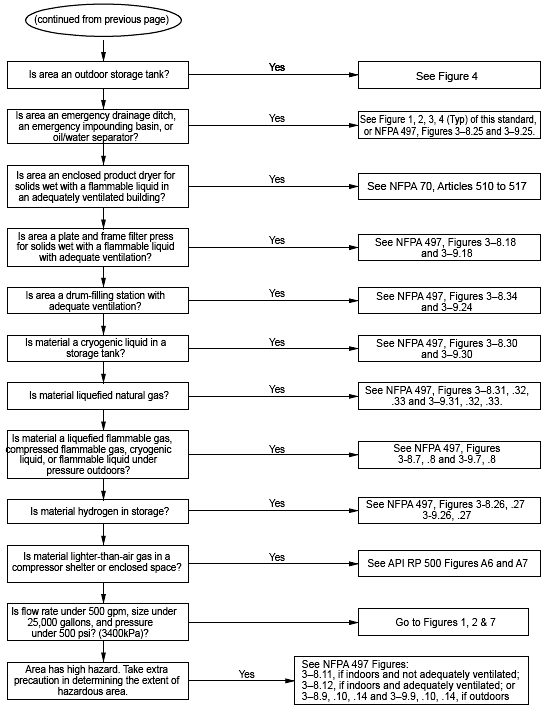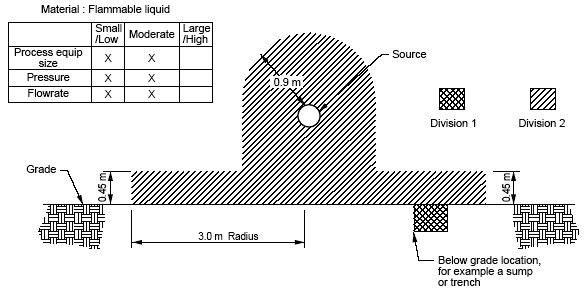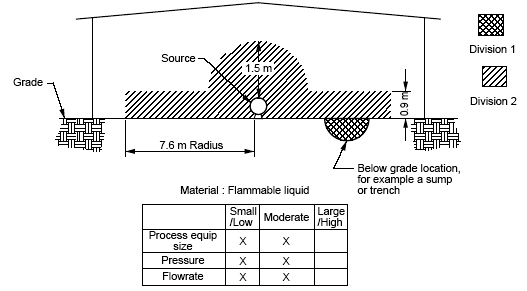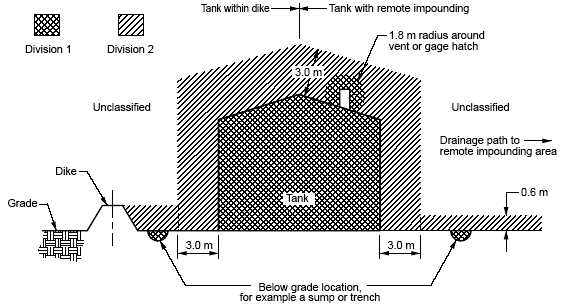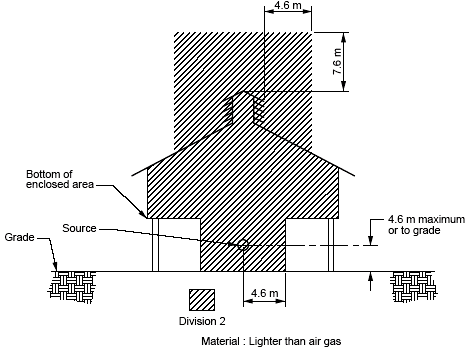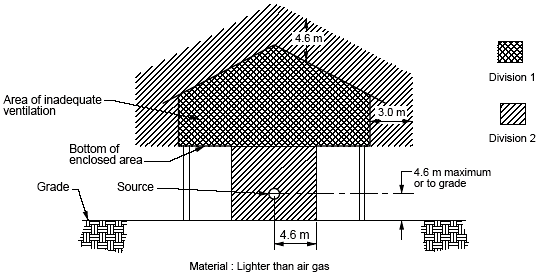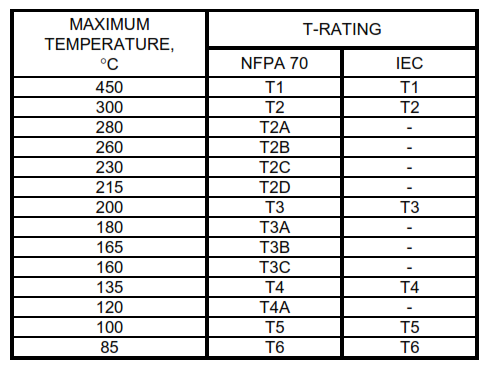This article is for determining the class and extent of hazardous areas for electrical installations where flammable gases or vapors, flammable liquids, combustible dust, or ignitable fibers or flyings are being stored, handled, or processed.

Hazardous Area Classification NEC
References
American Petroleum Institute (API)
RP 500 Recommended Practices of Classification of Locations for Electrical Installations at Petroleum Refineries
International Electrotechnical Commission (IEC)
60079-10 Explosives Atmospheres
National Electrical Manufacturer’s Association (NEMA)
Enclosures
National Fire Protection Association (NFPA)
30 Flammable and Combustible Liquids Code
45 Standard on Fire Protection for Laboratories Using Chemicals
70 National Electrical Code (NEC)
496 Standard for Purged and Pressured Enclosures for Electrical Equipment
497 Recommended Practice for the classification of Flammable Liquids, Gases, or Vapors and of Hazardous (Classified) Locations for Electrical Installations in Chemical Process Areas.
499 Recommended Practice for the classification of Combustible Dusts and of Hazardous (Classified) Locations for Electrical Installations in Chemical Process Areas.
HAZ10 Fire Protection Guide to Hazardous Materials
Hazardous Area Classification Definitions
For the purpose of understanding this standard, the following definitions apply.
NEC Class Locations
Class I Locations.
Locations in which combustible gases or vapors may be present in quantities sufficient to produce explosive or ignitable mixtures.
Group A. Atmospheres containing acetylene.
Group B. Atmospheres containing hydrogen, process gas containing more than 30 percent hydrogen by volume, butadiene, ethylene oxide, propylene oxide and acrolein.
Group C. Atmospheres containing ethyl ether, ethylene or gases and vapors of equivalent characteristics.
Group D. Atmospheres containing acetone, ammonia, benzene, butane, cyclopropane, ethanol, gasoline, hexane, methanol, methane, natural gas, naphtha, propane or gases and vapors of equivalent characteristics.
Class II Locations.
Locations in which combustible dust may be present in quantities sufficient to produce explosive or ignitable mixtures.
Group E. Atmospheres containing combustible metal dust, for example aluminum, magnesium, and their alloys.
Group F. Atmospheres containing combustible carbonaceous dust, for example carbon black, charcoal, or dusts sensitized by other materials, rendering them an explosion hazard.
Group G. Atmospheres containing combustible dusts not included in groups E or F, for example flour, grain, wood, plastics and chemicals.
Class III Locations.
Class III locations are those that are hazardous because of the presence of easily ignitable fibers or flyings, but in which the fibers or flyings are not likely to be in suspension in the air in quantities sufficient to produce ignitable mixtures. Class III locations shall include:
a. Division 1 location in which easily ignitable fibers or materials producing combustible flyings are handled, manufactured, or used
b. Division 2 location in which easily ignitable fibers are stored or handled
IEC Zones
Zone 0. Locations in which ignitable concentrations of flammable gases or vapors are present constantly or for long periods of time.
Zone 1. Locations in which ignitable concentrations of flammable gases or vapors:
a. Are likely under normal operating conditions
b. Exist frequently due to maintenance or repair operations
c. Exist due to equipment breakdowns or faulty operation and simultaneous electrical equipment failure making the electrical equipment a source of ignition
d. Exist due to being adjacent to a Class I, Zone 0 area, without adequate ventilation present
Zone 2. Locations in which ignitable concentrations of flammable gases or vapors:
a. Are not likely under normal conditions
b. Are usually confined in closed containers or systems
c. Are prevented by positive mechanical ventilation
d. Exist due to being adjacent to a Class 1, Zone 1 area, without adequate ventilation present
Combustible Liquid. NFPA 497 classifies flammable and combustible liquids according to their closed-cup flash points. The flash point is the temperature at which the vapor pressure is high enough to produce a flammable mixture in air.
Class I: Flash point below 37.8 °C (100 °F)
Class II: Flash point above 37.8 °C (100 °F) and below 60 °C (140 °F)
Class III: Flash point above 60 °C (140 °F)
Class I flammable liquids can produce large quantities of vapor, especially if released at elevated temperatures, but tend to disperse fairly rapidly into the atmosphere.
Class II liquids, unless released at elevated temperatures seldom cause appreciable hazard except near the surface of the liquid spill. Even if released at high temperature, the extent of the hazardous location is limited by the propensity of the vapors to condense as they cool to ambient temperature.
Class III liquids, because of their high flash point, seldom cause a hazard of significant extent, except at the surface of the heated liquid.
Flammable (Explosive) Limits. Where gases or vapors form flammable mixtures with air, oxygen or other gases, for example hydrogen, there are minimum concentrations of these mixtures below which propagation of flame does not occur on contact with a source of ignition. There is also a maximum proportional concentration of these mixtures above which propagation of flame does not occur upon contact with a source of ignition. The points at
which these changes in flammability occur are known as the ‘lower and upper flammable limits’.
Flammable Liquid. A liquid with a flash point equal to or less than 37.8 °C.
Hazardous Location. Areas which may contain hazardous materials in sufficient quantities to create an explosion when subjected to an electrical spark or arc.
Heavier than Air Gas or Vapor. A gas or vapor with a density under release conditions that is equal to or greater than 75 percent of that of air at atmospheric pressure and 15 °C. See Figures 1 to 4.
Figure 1 – Need for Classification Flowchart
Figure 2 – Figure Selection Flowchart
Figure 3 – Heavier Than Air Flammable Gas or Vapor Located at or Near Grade in an Adequately Ventilated Area
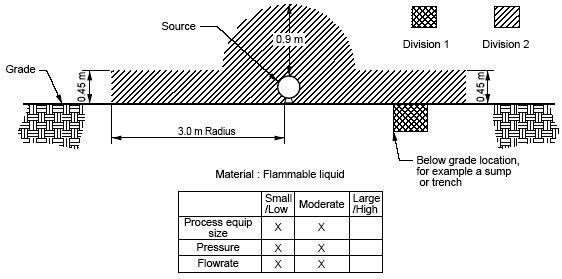
Figure 4 – Heavier Than Air Flammable Gas or Vapor Located Above Grade in an Adequately Ventilated Area
Lighter than Air Gas or Vapor. A gas or vapor with a density under release conditions that is less than 75 percent of that of air at atmospheric pressure and 15 °C. See Figures 5 to 8.
Figure 5 – Heavier Than Air Flammable Gas or Vapor Indoors in an Adequately Ventilated Area
Figure 6 – Tank with Heavier Than Air Flammable Gas or Vapor Source
Figure 7 – Lighter Than Air, Gas or Vapor in an Adequately Ventilated Indoor Area
Figure 8 – Lighter Than Air, Gas or Vapor in an Inadequately Ventilated Indoor Area
T-Rating / T-Code. A system used to designate the maximum operating temperatures on the surface of apparatus approved for use in hazardous locations. Apparatus approved for use in a hazardous area shall be marked with Class, Group and operating temperature. See Table IV for T-Ratings of both NFPA 70 and IEC applications.
Unclassified Locations
a. Locations where combustible substances are contained in closed systems in a way that the occurrence of combustible substances liberated into the air is so infrequent that quantities sufficient to produce explosive or ignitable mixtures do not occur, regardless of ventilation rate.
b. Locations surrounding continuous or intermittent ignition sources, for example unprotected fired vessels or flare tips.
c. Locations where ventilation (natural or artificial) is sufficient to prevent the accumulation of a sufficient quantity of the combustible substance to produce an explosive or ignitable mixture.
d. Interior enclosure spaces, not containing a source of combustible material release, located in classified areas, and pressurized or purged by inert gas, or by air taken from an unclassified location. (‘X’ or ‘Z’ type purge, NFPA 496).
General
- This standard cannot cover every situation that might be encountered. For example, major releases that might cause flammable concentrations for considerable distances. Classification and compliance with NFPA 70, Article 500 does not prevent other causes of ignition of flammable gases or vapors. For example, it does not protect against static electricity, lightning strikes, open flames, welding, mechanical sparks, or hot surfaces of process equipment and heaters. Protection from these hazards shall be provided. See Reducing Hazards of Static Electricity in Plant for protection against static electricity.
- Experienced process engineers, plant safety experts and corporate consultants shall develop area classification.
- The procedures outlined in the flow charts Figures 19, 20 and 21, along with the information provided in the text of this standard, shall be used in the evaluation of area classification requirements.
TABLE IV – Equivalent IEC to NFPA 70 T-Ratings
Subsequent Articles for this post are
Principles of Class I Areas – Hazardous Area Classification NEC
Principles of Class II Areas – Hazardous Area Classification NEC
Principles of Class I Areas – Hazardous Area Classification NEC
